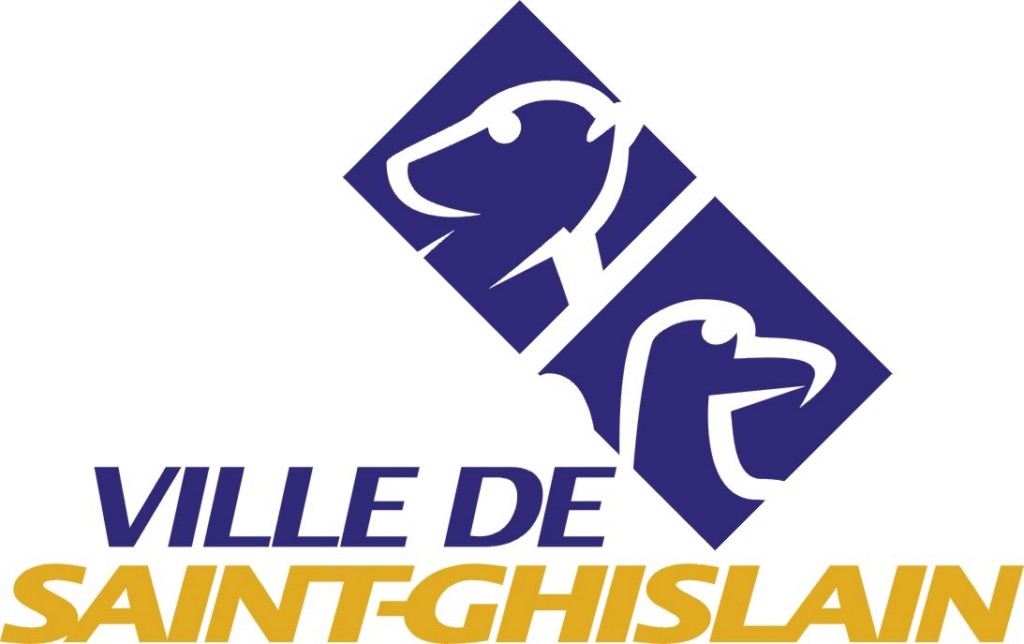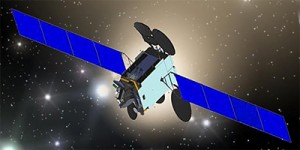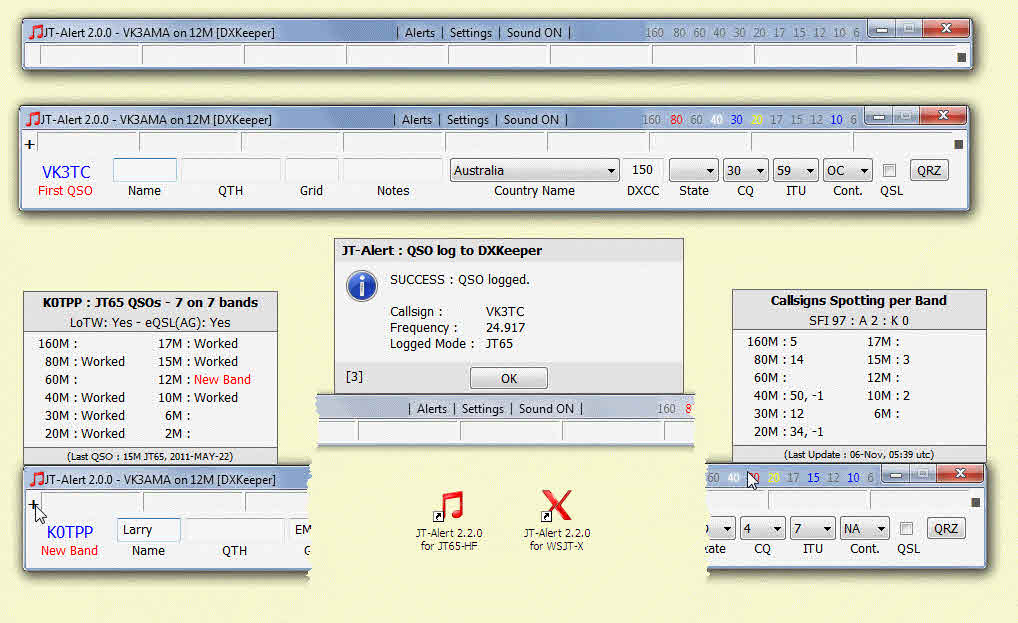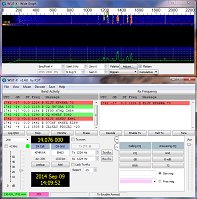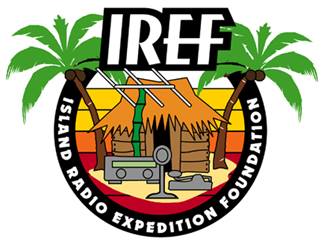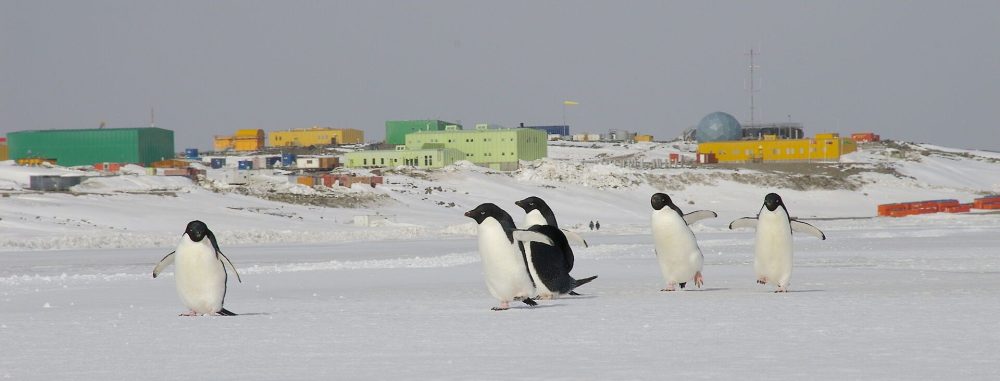 |
 Sobral Scientific Base ( Base Base Científica Sobral or Base Sobral) was a permanent, all year-round and now only partially active Argentine Antarctic base and scientific Research Station located on the Filchner Ice Shelf at 81°04′05″South, 40°36′01″West. It bears its name in honor of the late 19th and early 20th century Argentine explorer Ensign José María Sobral, who had joined Dr. Otto Nordenskjöld’s ill-fated Swedish Antarctic expedition in 1903. Josè Maria Sobral was the first Argentine known to winter in Antarctica.
Sobral Scientific Base ( Base Base Científica Sobral or Base Sobral) was a permanent, all year-round and now only partially active Argentine Antarctic base and scientific Research Station located on the Filchner Ice Shelf at 81°04′05″South, 40°36′01″West. It bears its name in honor of the late 19th and early 20th century Argentine explorer Ensign José María Sobral, who had joined Dr. Otto Nordenskjöld’s ill-fated Swedish Antarctic expedition in 1903. Josè Maria Sobral was the first Argentine known to winter in Antarctica.
The initial purpose of the Bse was to serve as a stopover on the route of the Argentine expedition to the South Pole, which was reached on December 10, 1965 in the so-called Operation 90.
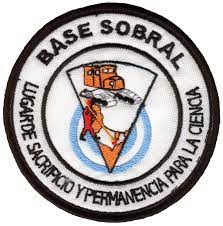 Sobral Base (WAP ARG-Ø3) was founded on April 2, 1965 by a crew of 5 men from the Belgrano I Base (WAP ARG-Ø5) who sent a message to Buenos Aires the following day urging them to speed up the departure of the polar expedition by the first days of October, given the ice instability. Thus, on October 26, 1965, a group of 10 men left the Belgrano I Base and a few days later arrived at Sobral Base, reaching the South Pole on December 10, 1965.
Sobral Base (WAP ARG-Ø3) was founded on April 2, 1965 by a crew of 5 men from the Belgrano I Base (WAP ARG-Ø5) who sent a message to Buenos Aires the following day urging them to speed up the departure of the polar expedition by the first days of October, given the ice instability. Thus, on October 26, 1965, a group of 10 men left the Belgrano I Base and a few days later arrived at Sobral Base, reaching the South Pole on December 10, 1965.
Sobral Base (420 km south of Belgrano base and 780 km north of the South Pole), could accommodate a maximum of 7 people. Because the ice from the barrier caused cracks in the structures, the Base was closed on October 28, 1968 after 3 years of continuous service, and was quickly buried under the ice of the Filchner barrier. In November 1983, a reconnaissance patrol on Ski-Doo motorcycles with tow sleds, made up of six men, set out for the first time from the Belgrano II Base (WAP ARG-Ø6) with the mission of establishing a new route between Belgrano II and Sobral Base. They managed to locate the objective and reactivate it after 15 years, carrying out maintenance, communications, meteorological measurements and topographic reconnaissance tasks up to the Diamante mountain range, in places not visited by man.  After 23 days of exploration, using nine days to go and four to return, they successfully returned to the Belgrano II leaving written testimonies in plastic tubes and marking the path with reeds and banners. After 14 years of this last reactivation, it was not possible to find it in 1997 when a patrol of 4 men from Belgrano II Base went in search of it. That patrol identified the place where the base should be located and established fuel depots for future operations in the region.
After 23 days of exploration, using nine days to go and four to return, they successfully returned to the Belgrano II leaving written testimonies in plastic tubes and marking the path with reeds and banners. After 14 years of this last reactivation, it was not possible to find it in 1997 when a patrol of 4 men from Belgrano II Base went in search of it. That patrol identified the place where the base should be located and established fuel depots for future operations in the region.
On December 13, 1999, a 7 man expedition that repeated the route to the South Pole arrived at the place indicated by the 1997 patrol, finding the remains of stakes and the Argentine flag, as well as fuel drums. The expedition searched for Sobral Base, finding it 11.5 km from its original position, finding the 3-meter-high antenna towers that protruded about 30 cm from the ice. The expedition members excavated the ice and managed to enter the base, staying there for two days.
 On 10 October 2000 a six-men research expedition established a scientific camp at Sobral’s emplacement and measured local ozone levels with a spectrophotometer. The temporary occupation was conducted by personnel belonging to Belgrano II and a technician from the National Antarctic Directorate; since then, a new expedition is sent every year between September and December, where the lowest annual average concentration of ozone in Antarctica is recorded.
On 10 October 2000 a six-men research expedition established a scientific camp at Sobral’s emplacement and measured local ozone levels with a spectrophotometer. The temporary occupation was conducted by personnel belonging to Belgrano II and a technician from the National Antarctic Directorate; since then, a new expedition is sent every year between September and December, where the lowest annual average concentration of ozone in Antarctica is recorded.
In order to reach the remote base this team must travel for distances up to 400 km (250 mi) over very rugged ice terrain filled with numerous cracks, which pose an often unpredictable threat. Snowcat heavy 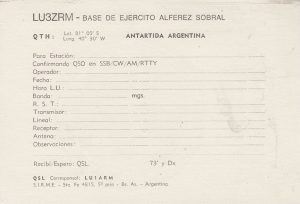 vehicles are used to cover half of the route; light vehicles like the Yamaha VK-540 II Ski-Doo are preferred for the rest. The party carries all the necessary equipment for a three-months stay, such as tents, fuel, supplies, survival kits, communication hardware and scientific instruments.
vehicles are used to cover half of the route; light vehicles like the Yamaha VK-540 II Ski-Doo are preferred for the rest. The party carries all the necessary equipment for a three-months stay, such as tents, fuel, supplies, survival kits, communication hardware and scientific instruments.
Sobral Base WAP ARG-Ø3, remains one of the most rare sites with very few Hamradio operations. 3 are the callsigns used from Base Sobral: LU1ZZ LU2ZZ and LU3ZRM.
.
TNX Olivier F6EPN (Spratley Woody) for the help in finding old QSL

La base scientifique de Sobral ( Base Base Científica Sobral ou Base Sobral) était une base et une station de recherche scientifique antarctique argentine permanente, toute l’année et désormais partiellement active. situé sur la plate-forme de glace Filchner à 81°04′05″Sud, 40°36′01″Ouest. Il porte son nom en l’honneur de l’explorateur argentin de la fin du 19e et du début du 20e siècle l’enseigne José María Sobral, qui avait rejoint la malheureuse expédition antarctique suédoise du Dr Otto Nordenskjöld en 1903. Josè Maria Sobral a été le premier Argentin connu à passer l’hiver en Antarctique.
Le but initial du Bse était de servir d’escale sur la route de l’expédition argentine vers le pôle Sud, qui a été atteint le 10 décembre 1965 dans le cadre de l’opération dite 90.
 Sobral Base (WAP ARG-Ø3) was founded on April 2, 1965 by a crew of 5 men from the Belgrano I Base (WAP ARG-Ø5) who sent a message to Buenos Aires the following day urging them to speed up the departure of the polar expedition by the first days of October, given the ice instability. Thus, on October 26, 1965, a group of 10 men left the Belgrano I Base and a few days later arrived at Sobral Base, reaching the South Pole on December 10, 196.
Sobral Base (WAP ARG-Ø3) was founded on April 2, 1965 by a crew of 5 men from the Belgrano I Base (WAP ARG-Ø5) who sent a message to Buenos Aires the following day urging them to speed up the departure of the polar expedition by the first days of October, given the ice instability. Thus, on October 26, 1965, a group of 10 men left the Belgrano I Base and a few days later arrived at Sobral Base, reaching the South Pole on December 10, 196.
Sobral Base (420 km au sud de la base de Belgrano et 780 km au nord du pôle Sud), pouvait accueillir un maximum de 7 personnes. Parce que la glace de la barrière a provoqué des fissures dans les structures, la Base a été fermée le 28 octobre 1968 après 3 ans de service continu, et a été rapidement ensevelie sous la glace de la barrière Filchner. En novembre 1983, une patrouille de reconnaissance sur motos Ski-Doo avec traîneaux remorqués, composée de six hommes, part pour la première fois de la Base Belgrano II (WAP ARG-Ø6) avec pour mission d’établir une nouvelle route entre Belgrano II et Sobral Base. Ils ont réussi à localiser l’objectif et à le réactiver après 15 ans, en effectuant des tâches de maintenance, de communication, de mesures météorologiques et de reconnaissance topographique jusqu’à la chaîne de montagnes du Diamante, dans des endroits non visités par l’homme.

Après 23 jours d’exploration, utilisant neuf jours aller et quatre jours retour, ils sont revenus avec succès au Belgrano II en laissant des témoignages écrits dans des tubes en plastique et en marquant le chemin avec des roseaux et des bannières. Après 14 ans de cette dernière réactivation, il n’a pas été possible de le retrouver en 1997 lorsqu’une patrouille de 4 hommes de la Base Belgrano II est partie à sa recherche. Cette patrouille a identifié l’endroit où la base devrait être située et a établi des dépôts de carburant pour les opérations futures dans la région.
Le 13 décembre 1999, une expédition de 7 hommes qui a répété la route vers le pôle Sud est arrivée à l’endroit indiqué par la patrouille de 1997, trouvant les restes de pieux et le drapeau argentin, ainsi que des fûts de carburant. L’expédition a recherché la base de Sobral, la trouvant à 11,5 km de sa position d’origine, trouvant les tours d’antenne de 3 mètres de haut qui dépassaient d’environ 30 cm de la glace. Les membres de l’expédition ont creusé la glace et ont réussi à entrer dans la base, y restant pendant deux jours.

Le 10 octobre 2000, une expédition de recherche de six hommes a établi un camp scientifique à l’emplacement de Sobral et a mesuré les niveaux d’ozone locaux avec un spectrophotomètre. L’occupation temporaire a été effectuée par du personnel appartenant à Belgrano II et un technicien de la Direction nationale de l’Antarctique ; depuis lors, une nouvelle expédition est envoyée chaque année entre septembre et décembre, où la plus faible concentration moyenne annuelle d’ozone en Antarctique est enregistrée.
Afin d’atteindre la base éloignée, cette équipe doit parcourir des distances allant jusqu’à 400 km (250 mi) sur un terrain de glace très accidenté rempli de nombreuses fissures, qui constituent une menace souvent imprévisible. Snowcat lourd  les véhicules sont utilisés pour couvrir la moitié de l’itinéraire ; les véhicules légers comme le Yamaha VK-540 II Ski-Doo sont à privilégier pour le reste. Le groupe transporte tout l’équipement nécessaire pour un séjour de trois mois, comme des tentes, du carburant, des fournitures, des kits de survie, du matériel de communication et des instruments scientifiques.
les véhicules sont utilisés pour couvrir la moitié de l’itinéraire ; les véhicules légers comme le Yamaha VK-540 II Ski-Doo sont à privilégier pour le reste. Le groupe transporte tout l’équipement nécessaire pour un séjour de trois mois, comme des tentes, du carburant, des fournitures, des kits de survie, du matériel de communication et des instruments scientifiques.
Sobral Base WAP ARG-Ø3, reste l’un des sites les plus rares avec très peu d’opérations Hamradio. 3 sont les indicatifs utilisés depuis Base Sobral : LU1ZZ LU2ZZ et LU3ZRM.
.
TNX Olivier F6EPN (Spratley Woody) pour son aide dans la recherche de l’ancienne QSL
Info de la Source Publié * ICI

